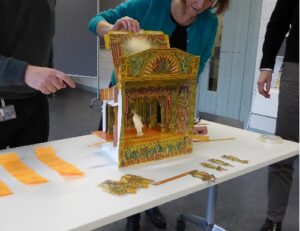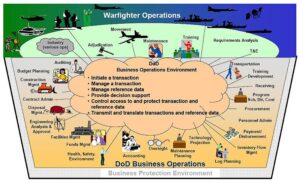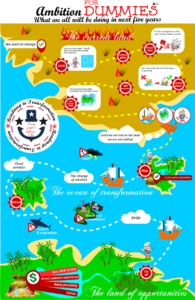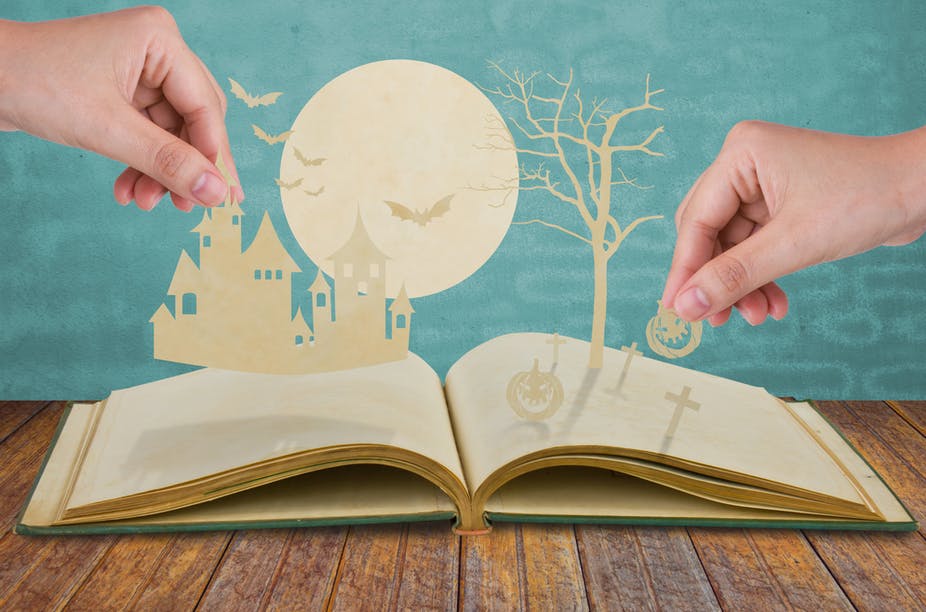What’s the best way to get people to follow a strategy? Short-answer: build a story that makes sense to everyone. A story that shows how everything connects together, all the way from big-picture strategy to front-line action. A story where everyone can see what part they play, and how that role connects with everything else. You know – a story.
Actually, there are several different types of stories that we are likely to need. One is the story that we would create in a workshop or the like when we build ideas for change. We would typically do that on a whiteboard, but I also like to turn it into literally tangible form. For example, I have often got stakeholders to describe their own story with Lego figures, with a wooden toy-train, or scenes on the stage of a toy-theatre. Make the building of the story FUN!

Toy-theatre in use on planning a digital-change project for a city (source: Tom Graves)
Another kind of story is where we describe what the world will look like when the change is done. We can do this in text, of course, but a picture is usually better: ‘every picture tells a story’ and all that. A ‘rich-picture’ is actually a mandatory requirement in some standards such as DoDAF, with its OV-1 or High-Level Operational Concept Graphic, which shows all of the main elements of the finished project and how they work together.

Rich-picture of a military project (source: US Dept of Defense – public domain via Wikimedia)
Whatever you do, though, make it human; make it accessible, understandable. It has to be readable by everyone. (Technical-diagrams rarely work well for this: don’t make the mistake that I once did, showing a BPMN diagram to a bunch of executives – not a good idea!)
And take the classic roadmap: make it into an actual story of change. There’s a lovely example of this by Ondrej Galik, where he describes the change-project as a voyage by sea to a new land.

Change-journey of a digital-transformation project for a bank (source: Ondrej Galik)
Ondrej’s diagram starts at the top with the ‘Why’ – the ‘burning land’ that explains the reason why the change is essential for the business and its future. Moving down, he shows what will be needed for the journey: things, people and their skills, checklists and so on. Then there are the stages of the journey: places to rest, storms in the Cloud, avoiding the pirates who steal commitment, or the sharks of data-migration, the fog of cloud-services, data-warehouse and BYOD. Finally, there are the signs that show when they have arrived at the Land of Opportunity: one-click-to-buy, great customer experience, and so on.
You could do the same with a customer-journey: make that into a story of a journey, so that you see and describe each of the actions, the transitions, the moments of change. Or even depict the role and purpose of the entire enterprise, where the enterprise is the story.
So how do we tell a story? It’s not hard: most of it is just the usual lists of who, what, when, where, how and why, all strung together into a sequence that makes sense. Who are the actors and other agents, the people and machines? What are their roles in the story? What things will they need, to do their own work, and to support the next stage in the story? When will it happen – the events of the story? Where will each stage happen? How will it happen – the actions, and how they connect together? And why will it happen – each stage, each transition, and the purpose of the story as a whole?
We can make anything into a story: that’s what makes it make sense, that’s what brings people together, that’s what connects everything together, everyone together, across the whole. But perhaps most important of all, stories are fun! – and that’s what makes it work, and makes the work itself worthwhile. Enjoy!
From the desk of the Editor: If you would like to reach out to Tom to learn more about story telling, do drop us an email and we would be delighted to connect you.


